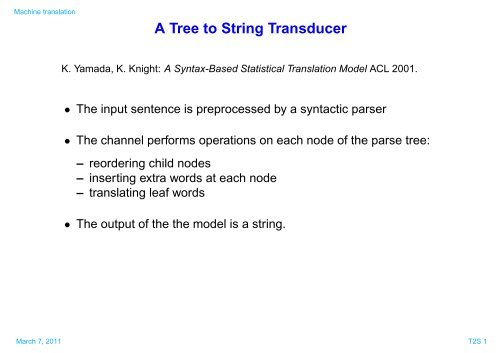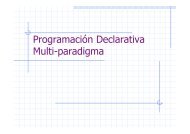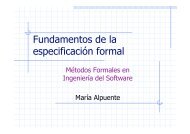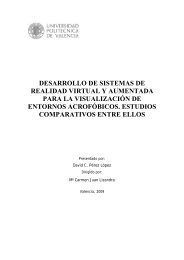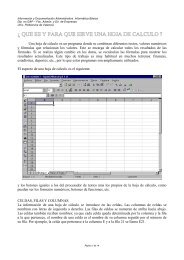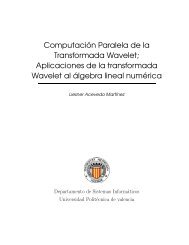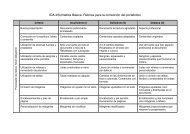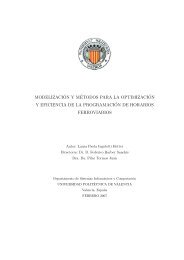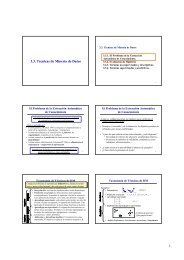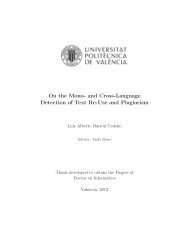A Tree to String Transducer
A Tree to String Transducer
A Tree to String Transducer
You also want an ePaper? Increase the reach of your titles
YUMPU automatically turns print PDFs into web optimized ePapers that Google loves.
Machine translation<br />
A <strong>Tree</strong> <strong>to</strong> <strong>String</strong> <strong>Transducer</strong><br />
K. Yamada, K. Knight: A Syntax-Based Statistical Translation Model ACL 2001.<br />
• The input sentence is preprocessed by a syntactic parser<br />
• The channel performs operations on each node of the parse tree:<br />
– reordering child nodes<br />
– inserting extra words at each node<br />
– translating leaf words<br />
• The output of the the model is a string.<br />
March 7, 2011 T2S 1
Machine translation<br />
Parse <strong>Tree</strong>(E)<br />
PRP VB1<br />
VB<br />
PRP VB2 VB1<br />
he ha<br />
he adores<br />
TO VB<br />
MN TO<br />
music<br />
Sentence(J)<br />
<strong>to</strong><br />
VB<br />
listening<br />
VB2<br />
VB TO<br />
TO<br />
<strong>to</strong><br />
ga<br />
listening no<br />
MN<br />
music<br />
adores<br />
An Example ∗<br />
desu<br />
Reorder<br />
Insert<br />
Translate<br />
Take Leaves<br />
VB<br />
PRP VB2 VB1<br />
he<br />
TO VB<br />
MN TO<br />
music<br />
Kare ha ongaku wo kiku no ga daisuki desu<br />
<strong>to</strong><br />
listening<br />
VB<br />
adores<br />
PRP VB2 VB1<br />
kare ha<br />
TO VB<br />
MN TO<br />
ongaku wo kiku<br />
∗ Source: http://www.isi.edu/natural-language/people/cs562-8-22-06.pdf<br />
March 7, 2011 T2S 2<br />
ga<br />
no<br />
daisuki<br />
desu<br />
.
Machine translation<br />
⇒ The reordering is decided according <strong>to</strong> the r-table<br />
VB<br />
PRP VB1 VB2<br />
He adores VB TO<br />
listening TO NN<br />
original order reordering P(reorder)<br />
PRP VB1 VB2 0.074<br />
PRP VB2 VB1 0.723<br />
PRP VB1 VB2 VB1 PRP VB2 0.061<br />
· · · · · ·<br />
VB TO VB TO 0.252<br />
TO VB 0.749<br />
TO NN TO NN 0.107<br />
NN TO 0.893<br />
· · · · · ·<br />
<strong>to</strong> music<br />
VB<br />
PRP VB2<br />
VB1<br />
He TO VB adores<br />
NN<br />
music<br />
Reordering probability: 0.723 · 0.749 · 0.893 = 0.484<br />
TO<br />
<strong>to</strong><br />
listening<br />
March 7, 2011 T2S 3
Machine translation<br />
⇒The insertion of a new node is decided according <strong>to</strong> the n-table<br />
VB<br />
PRP VB2<br />
VB1<br />
parent TOP VB VB VB TO TO · · ·<br />
node VB VB PRP TO TO NN · · ·<br />
P(None) 0.735 0.687 0.344 0.709 0.900 0.800 · · ·<br />
P(Left) 0.004 0.061 0.004 0.030 0.003 0.096 · · ·<br />
P(right) 0.260 0.252 0.652 0.261 0.007 0.104 · · ·<br />
He TO VB adores<br />
NN<br />
music<br />
TO<br />
<strong>to</strong><br />
listening<br />
VB<br />
w P(ins-w)<br />
ha 0.219<br />
ta 0.131<br />
wo 0.099<br />
no 0.094<br />
ni 0.080<br />
te 0.078<br />
ga 0.062<br />
. .<br />
desu 0.0007<br />
PRP VB2<br />
VB1<br />
He ha TO VB ga adores desu<br />
NN<br />
music<br />
TO<br />
listening no<br />
Insertion probability: (0.652·0.219)·(0.252·0.094)·(0.252·0.062)·(0.252·0.0007)·<br />
0.735 · 0.709 · 0.900 · 0.800 = 3.498e − 9<br />
March 7, 2011 T2S 4<br />
<strong>to</strong><br />
.<br />
.
Machine translation<br />
⇒The translation is decided according <strong>to</strong> the t-table<br />
adores he listening music <strong>to</strong> · · ·<br />
daisuki 1.000 kare 0.952 kiku 0.333 ongaku 0.900 ni 0.216 · · ·<br />
NULL 0.016 kii 0.333 naru 0.100 NULL 0.204<br />
nani 0.005 mi 0.333 <strong>to</strong> 0.133<br />
VB<br />
PRP VB2<br />
VB1<br />
He ha TO VB ga adores desu<br />
NN<br />
music<br />
TO<br />
<strong>to</strong><br />
listening no<br />
.<br />
.<br />
.<br />
.<br />
.<br />
VB<br />
PRP VB2<br />
VB1<br />
kare ha TO VB ga daisuki desu<br />
NN<br />
ongaku<br />
TO<br />
wo<br />
.<br />
kiku no<br />
Translation probability: 0.952 · 0.900 · 0.038 · 1.000 = 0.0108<br />
March 7, 2011 T2S 5
Machine translation<br />
Formal description<br />
• Goal: Transform an English parse tree E in<strong>to</strong> a French sentence f<br />
• Definitions<br />
- E consists of nodes ε1, ε2,...,εn<br />
- f consists of words f1,f2, ...,fn<br />
- θi = (νi,ρi, τi) is a set of values of random variables associated <strong>to</strong> εi<br />
- θ = θ1,θ2, ...,θn is the set of all random variables associated with a parse<br />
tree E = ε1, ε2,...,εn<br />
P(f|E) =<br />
<br />
P(θ|E)<br />
θ:Str(θ(E))=f<br />
P(θ|E) = P(θ1, θ2, ...,θn|ε1,ε2, ...,εn)<br />
n<br />
= P(θi|θ1, θ2, ...,θn,ε1, ε2,...,εn)<br />
≈<br />
i=1<br />
n<br />
P(θi|εi)<br />
i=1<br />
March 7, 2011 T2S 6
Machine translation<br />
Where<br />
Formal description<br />
P(θi|εi) = P(νi, ρi,τi|εi) ≈ P(νi|εi)P(ρi|εi)P(τi|εi)<br />
= P(νi|N(εi))P(ρi|R(εi))P(τi|T (εi))<br />
= n(νi|N(εi))r(ρi|R(εi))t(τi|T (εi))<br />
n(ν|N(ε)) ≡ n(ν|N), r(ρ|R(ε)) ≡ r(ρ|R), t(τ|T (ε)) ≡ t(τ|T)<br />
are the parameters of the model<br />
For example:<br />
• n(ν|N) = P(right, ha|VB − PRP)<br />
• r(ρ|R) = P(PRP − VB2 − VB1|PRP − VB1 − VB2)<br />
P(f|E) = <br />
θ:Str(θ(E))=f<br />
n<br />
i=1 n(νi|N(εi))r(ρi|R(εi))t(τi|T (εi))<br />
March 7, 2011 T2S 7
Machine translation<br />
Estimation of the parameters<br />
1. Initialize all probability tables: n(ν|N), r(ρ|R) and t(τ|T)<br />
2. Reset all counters: c(ν, N), c(ρ, R) and c(τ, T)<br />
3. For each pair 〈E,f〉 in the training corpus<br />
For all θ , such that f = Str(θ(E))<br />
- Let cnt = P(θ|E)/ <br />
θ:Str(θ(E))=f P(θ|E)<br />
- For i = 1...n,<br />
c(νi, N(εi))+ = cnt<br />
c(ρi, R(εi))+ = cnt<br />
c(τi, T (εi))+ = cnt<br />
4. For each 〈ν, N〉, 〈ρ, R〉, and 〈τ, T 〉<br />
n(ν|N) = c(ν, N)/ <br />
ν<br />
c(ν, N)<br />
r(ρ|R) = c(ρ, R)/ <br />
ρ c(ρ, R)<br />
t(τ|T) = c(τ, T)/ <br />
τ<br />
c(τ, T)<br />
5. Repeat steps 2-4 for several iterations<br />
March 7, 2011 T2S 8
Machine translation<br />
Efficient EM training<br />
The EM algorithm uses a graph structure for a pair 〈E,f〉<br />
• A major-node v(εi,f l k ) shows a pairing of a subtree of E and a substring of f<br />
• Each major node connects <strong>to</strong> several ν-subnode v(ν; εi,f l k ), showing which<br />
value of ν is selected. The arc has weight P(ν|εi)<br />
• A ν-subnode v(ν; εi,f l k ) connects <strong>to</strong> a<br />
final-node with weight P(τ|εi) if εi is a<br />
terminal node<br />
• A ν-subnode connects <strong>to</strong> several ρsubnodes<br />
v(ρ; ν, εi,f l P(ρ|εi)<br />
k ) with weight<br />
• A ρ-subnode is connected <strong>to</strong> π-subnodes<br />
v(π; ρ, ν, εi,f l k ) with weight 1.0. The<br />
variable π shows a particular way of<br />
partitioning fl k<br />
P(ν|ε)<br />
P(ρ|ε)<br />
major-node<br />
ν-subnode<br />
ρ-subnode<br />
π-subnode<br />
• A π-subnode is connected <strong>to</strong> major-nodes corresponding <strong>to</strong> children of εi<br />
with weight 1.0. A major-node can be connected from different π-subnodes.<br />
major-node<br />
March 7, 2011 T2S 9
Machine translation<br />
Efficient EM training<br />
• A trace starting from the graph root, selecting one of the arcs from<br />
major-nodes, ν-subnodes and ρ-subnodes and all the arcs from πsubnodes<br />
corresponds <strong>to</strong> a particular <strong>to</strong> a particular θ<br />
• The product of the weight on the trace corresponds <strong>to</strong> P(θ|E)<br />
• An estimation algorithm similar <strong>to</strong> the inside-outside algorithm can<br />
be defined.<br />
• The time complexity is O(n 3 |ν||ρ||π|)<br />
March 7, 2011 T2S 10
Machine translation<br />
Decoder description<br />
K. Yamada, K. Knight: A decoder for Syntax-based Statistical MT ACL 2001.<br />
Modifications <strong>to</strong> the original MT for phrasal translations:<br />
• Fertility µ is used <strong>to</strong> allow 1-<strong>to</strong>-N mapping:<br />
t(τ|T) = t(f1f2 ...fl|e) = µ(l|e)<br />
l<br />
t(fi|e)<br />
• Direct translation φ of an English phrase e1e2 ...em <strong>to</strong> a foreign phrase<br />
f1f2 ...fl at non-terminal tree nodes:<br />
i=1<br />
ph(φ|Φ) = t(f1f2 . . .fl|e1e2 ...em) = µ(l|e1e2 . ..em)<br />
• Linear mix (if εi is non-terminal):<br />
l<br />
t(fi|e1e2 ...em)<br />
i=1<br />
P(θi|εi) = λΦi ph(φi|Φi) + (1 − λΦi )r(ρi|Ri)n(νi|Ni)<br />
March 7, 2011 T2S 11
Machine translation<br />
Decoder description<br />
• Given a French sentence, the decoder will find the most plausible English<br />
parse tree<br />
• Idea: a mechanism similar <strong>to</strong> normal parsing is used<br />
• Steps:<br />
1. Start from an English context-free grammar and incorporate <strong>to</strong> it the<br />
channel operations<br />
2. For each non-lexical rule (such as “VP → VB NP PP”), supplement the<br />
grammar with reordered rules and probabilities are taken from the r-table<br />
3. Rules such as “VP → VP X” and “X → word” are added and probabilities<br />
are taken from the n-table<br />
4. For each lexical rule in the English grammar, we add rules such as<br />
“englishWord → foreingWord”<br />
5. Parse a string of foreign words<br />
6. Undo reordering operations and remove leaf nodes with foreign words<br />
7. Among all possible tree, choose pick the best in which the product of the<br />
LM and the TM probability is the highest<br />
March 7, 2011 T2S 12


